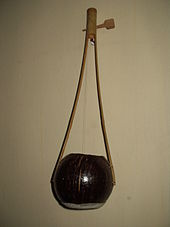Our website is made possible by displaying online advertisements to our visitors.
Please consider supporting us by disabling your ad blocker.
Baul


| Part of a series on the |
| Culture of Bengal |
|---|
 |
| History |
| Cuisine |
| Part of a series on |
| Bengalis |
|---|
 |
| Baul songs | |
|---|---|
| Country | Bangladesh |
| Reference | 00107 |
| Region | Asia and the Pacific |
| Inscription history | |
| Inscription | 2008 (3rd session) |
| List | Representative |
The Baul (Bengali: বাউল) are a group of mystic minstrels of mixed elements of Sufism and Vaishnavism from different parts of Bangladesh and the neighboring Indian states of West Bengal, Tripura and Assam's Barak Valley and Meghalaya.[1][2] Bauls constitute both a syncretic religious sect of troubadours and a musical tradition. Bauls are a very heterogeneous group, with many sects, but their membership mainly consists of Vaishnava Hindus and Sufi Muslims.[3][4] They can often be identified by their distinctive clothes and musical instruments. Lalon Shah is regarded as the most celebrated Baul saint in history.[5][6][7]
Although Bauls constitute only a small fraction of the Bengali population, their influence on the culture of Bengal is considerable. In 2005, the "Baul tradition of Bangladesh" was included in the list of Masterpieces of the Oral and Intangible Heritage of Humanity by UNESCO.[8]

- ^ "Baul | Folk Singers, Mysticism & Sufism | Britannica". www.britannica.com. Retrieved 15 June 2024.
- ^ "Baul - Banglapedia". en.banglapedia.org. Retrieved 15 June 2024.
- ^ "Baul (Indian music)". Encyclopædia Britannica Online. 18 June 2015.
- ^ "Bauled over". The Times of India. 6 February 2010. Archived from the original on 4 November 2012. Retrieved 4 July 2013.
- ^ World and its People: Eastern and Southern Asia. New York: Marshal Cavendish Corporation. 2007. p. 480. ISBN 978-0-7614-7631-3.
- ^ Paul, Harendra Chandra (1987). "Origin of the Bauls and their Philosophy". In Khan, Shamsuzzaman (ed.). Folklore of Bangladesh. Vol. 1. Dhaka: Bangla Academy. p. 257.
Faquir Lalan-Shah (1775–1891 A.D.), its greatest exponent
- ^ Chowdhury, Kabir (1985). Folk Poems From Bangladesh. Dhaka: Bangla Academy. pp. ii.
- ^ Masterpieces of the Oral and Intangible Heritage of Humanity. UNESCO. 25 September 2005.
Previous Page Next Page


